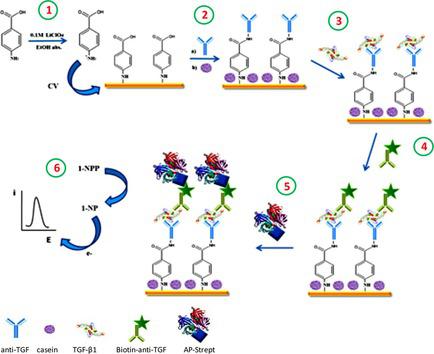当前位置:
X-MOL 学术
›
Electroanalysis
›
论文详情
Our official English website, www.x-mol.net, welcomes your feedback! (Note: you will need to create a separate account there.)
Screen‐printed Gold Electrodes Functionalized with Grafted p‐Aminobenzoic Acid for the Construction of Electrochemical Immunosensors. Determination of TGF‐β1 Cytokine in Human Plasma
Electroanalysis ( IF 3 ) Pub Date : 2018-02-01 , DOI: 10.1002/elan.201700744 Sara Guerrero 1 , Lourdes Agüí 1 , Paloma Yáñez-Sedeño 1 , José M. Pingarrón 1
Electroanalysis ( IF 3 ) Pub Date : 2018-02-01 , DOI: 10.1002/elan.201700744 Sara Guerrero 1 , Lourdes Agüí 1 , Paloma Yáñez-Sedeño 1 , José M. Pingarrón 1
Affiliation

|
Screen‐printed gold electrodes were modified with grafted p‐aminobezoic acid to provide scaffolds with high loading of surface confined carboxyl groups that can be used to construct electrochemical immunosensors. As a specific application, an immunosensor for the determination of the cytokine transforming growth factor beta 1 (TGF‐β1) is reported. The capture antibody (anti‐TGF) was covalently immobilized on the surface of the prepared disposable scaffold and a sandwich‐type immunoassay was implemented with biotinylated detector antibody (Biotin‐anti‐TGF) and streptavidin labeled with alkaline phosphatase (AP‐Strept). The transduction event was monitored by differential pulse voltammetry after addition of 1‐naphthyl phosphate (1‐NPP) as the enzyme substrate. The different variables affecting the preparation and the analytical behavior of the AP‐Strept‐Biotin‐anti‐TGF‐TGF‐β1‐anti‐TGF‐SPAuE immunosensor were optimized, and the functionalized gold electrodes and the prepared immunosensor were characterized using several techniques. A linear range extending between 0.05 and 3.0 ng/mL TGF‐β1, adequate for the determination of the cytokine in human plasma, and a LOD of 10 pg/mL, better than that claimed for commercial ELISA kits, were achieved. The immunosensor exhibits also a great selectivity against other proteins and an excellent storage ability. The usefulness of the immunosensor was demonstrated by analyzing human plasma spiked with TGF‐β1.
中文翻译:

用嫁接的对氨基苯甲酸官能化的丝网印刷金电极,用于构建电化学免疫传感器。血浆中TGF-β1细胞因子的测定
用嫁接的对氨基苯甲酸修饰丝网印刷的金电极,以提供具有高表面受限羧基负载量的支架,可用于构建电化学免疫传感器。作为一种特殊应用,报道了一种用于确定细胞因子转化生长因子β1(TGF-β1)的免疫传感器。将捕获抗体(抗TGF)共价固定在准备好的一次性支架的表面上,并用生物素化的检测抗体(Biotin-anti-TGF)和用碱性磷酸酶标记的抗生蛋白链菌素(AP-Strept)进行夹心型免疫测定。在添加1-萘基磷酸酯(1-NPP)作为酶底物后,通过差分脉冲伏安法监测转导事件。优化了影响AP-Strept-生物素-抗TGF-TGF-β1-抗TGF-SPAuE免疫传感器的制备和分析行为的不同变量,并使用多种技术对功能化的金电极和制备的免疫传感器进行了表征。线性范围介于0.05至3.0 ng / mLTGF-β1之间,足以确定人血浆中的细胞因子,LOD为10 pg / mL,优于商业ELISA试剂盒。免疫传感器还表现出对其他蛋白质的极大选择性和出色的存储能力。通过分析掺有TGF-β1的人血浆证明了免疫传感器的有用性。利用几种技术对功能化的金电极和制备的免疫传感器进行了表征。线性范围介于0.05至3.0 ng / mLTGF-β1之间,足以确定人血浆中的细胞因子,LOD为10 pg / mL,优于商业ELISA试剂盒。免疫传感器还表现出对其他蛋白质的极大选择性和出色的存储能力。通过分析掺有TGF-β1的人血浆证明了免疫传感器的有用性。利用几种技术对功能化的金电极和制备的免疫传感器进行了表征。线性范围介于0.05至3.0 ng / mLTGF-β1之间,足以确定人血浆中的细胞因子,LOD为10 pg / mL,优于商业ELISA试剂盒。免疫传感器还表现出对其他蛋白质的极大选择性和出色的存储能力。通过分析掺有TGF-β1的人血浆证明了免疫传感器的有用性。免疫传感器还表现出对其他蛋白质的极大选择性和出色的存储能力。通过分析掺有TGF-β1的人血浆证明了免疫传感器的有用性。免疫传感器还表现出对其他蛋白质的极大选择性和出色的存储能力。通过分析掺有TGF-β1的人血浆证明了免疫传感器的有用性。
更新日期:2018-02-01
中文翻译:

用嫁接的对氨基苯甲酸官能化的丝网印刷金电极,用于构建电化学免疫传感器。血浆中TGF-β1细胞因子的测定
用嫁接的对氨基苯甲酸修饰丝网印刷的金电极,以提供具有高表面受限羧基负载量的支架,可用于构建电化学免疫传感器。作为一种特殊应用,报道了一种用于确定细胞因子转化生长因子β1(TGF-β1)的免疫传感器。将捕获抗体(抗TGF)共价固定在准备好的一次性支架的表面上,并用生物素化的检测抗体(Biotin-anti-TGF)和用碱性磷酸酶标记的抗生蛋白链菌素(AP-Strept)进行夹心型免疫测定。在添加1-萘基磷酸酯(1-NPP)作为酶底物后,通过差分脉冲伏安法监测转导事件。优化了影响AP-Strept-生物素-抗TGF-TGF-β1-抗TGF-SPAuE免疫传感器的制备和分析行为的不同变量,并使用多种技术对功能化的金电极和制备的免疫传感器进行了表征。线性范围介于0.05至3.0 ng / mLTGF-β1之间,足以确定人血浆中的细胞因子,LOD为10 pg / mL,优于商业ELISA试剂盒。免疫传感器还表现出对其他蛋白质的极大选择性和出色的存储能力。通过分析掺有TGF-β1的人血浆证明了免疫传感器的有用性。利用几种技术对功能化的金电极和制备的免疫传感器进行了表征。线性范围介于0.05至3.0 ng / mLTGF-β1之间,足以确定人血浆中的细胞因子,LOD为10 pg / mL,优于商业ELISA试剂盒。免疫传感器还表现出对其他蛋白质的极大选择性和出色的存储能力。通过分析掺有TGF-β1的人血浆证明了免疫传感器的有用性。利用几种技术对功能化的金电极和制备的免疫传感器进行了表征。线性范围介于0.05至3.0 ng / mLTGF-β1之间,足以确定人血浆中的细胞因子,LOD为10 pg / mL,优于商业ELISA试剂盒。免疫传感器还表现出对其他蛋白质的极大选择性和出色的存储能力。通过分析掺有TGF-β1的人血浆证明了免疫传感器的有用性。免疫传感器还表现出对其他蛋白质的极大选择性和出色的存储能力。通过分析掺有TGF-β1的人血浆证明了免疫传感器的有用性。免疫传感器还表现出对其他蛋白质的极大选择性和出色的存储能力。通过分析掺有TGF-β1的人血浆证明了免疫传感器的有用性。



























 京公网安备 11010802027423号
京公网安备 11010802027423号